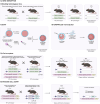Blastocyst complementation: current progress and future directions in xenogeneic organogenesis
- PMID: 40551151
- PMCID: PMC12186422
- DOI: 10.1186/s13287-025-04426-y
Blastocyst complementation: current progress and future directions in xenogeneic organogenesis
Abstract
The generation of organs derived from pluripotent stem cells can be achieved in vivo through the blastocyst complementation technique. This method is based on the introduction of pluripotent stem cells into organogenesis-disabled pre-implantation embryos, where environmental signals instruct donor cells to colonize the vacant niche and to develop into the missing organ. When applied interspecies, this approach has the potential to produce human organs in genetically engineered livestock, offering a promising solution to the global transplants' shortage crisis. In this review, we summarize the current progress in blastocyst complementation research and highlight the key challenges that must be addressed to advance this field.
Keywords: Blastocyst complementation; Chimera; Interspecies organogenesis; Organ generation; Organ transplantation; Pluripotent stem cells.
© 2025. The Author(s).
Conflict of interest statement
Declarations. Ethics approval and consent to participate: Not applicable. Consent for publication: Not applicable. Competing Interests: The authors declare no competing interests.
Figures



Similar articles
-
Recent advances in interspecies chimeras and organogenesis.Curr Opin Genet Dev. 2025 Aug;93:102368. doi: 10.1016/j.gde.2025.102368. Epub 2025 Jun 4. Curr Opin Genet Dev. 2025. PMID: 40480042 Review.
-
The road to generating transplantable organs: from blastocyst complementation to interspecies chimeras.Development. 2021 Jun 15;148(12):dev195792. doi: 10.1242/dev.195792. Epub 2021 Jun 16. Development. 2021. PMID: 34132325 Free PMC article.
-
Derivation of resident macrophages and construction of tumor microenvironment in Flk-1-knockout chimeric mice produced via blastocyst complementation.Sci Rep. 2025 Jul 29;15(1):27665. doi: 10.1038/s41598-025-12571-w. Sci Rep. 2025. PMID: 40730607 Free PMC article.
-
Toward developing human organs via embryo models and chimeras.Cell. 2024 Jun 20;187(13):3194-3219. doi: 10.1016/j.cell.2024.05.027. Cell. 2024. PMID: 38906095 Free PMC article.
-
Generating Human Organs via Interspecies Chimera Formation: Advances and Barriers.Yale J Biol Med. 2018 Sep 21;91(3):333-342. eCollection 2018 Sep. Yale J Biol Med. 2018. PMID: 30258320 Free PMC article. Review.
References
-
- European Commission Public Health [Internet]. Organs. Available from: https://health.ec.europa.eu/blood-tissues-cells-and-organs/organs_en
-
- Eurotransplant International Foundation [Internet]. Statistics Report Library. Available from: https://statistics.eurotransplant.org/index.php?search_type=waiting+list...=
-
- European Kidney Health Alliance [Internet]. The Alarming Rise in Chronic Kidney Disease in Europe: How to deal with this costly problem. Available from: https://ekha.eu/wp-content/uploads/2021/11/2013-Alarming-Rise-in-Chronic...
-
- Vis A, Arfaee M, Khambati H, Slaughter MS, Gummert JF, Overvelde JTB, et al. The ongoing quest for the first total artificial heart as destination therapy. Nat Rev Cardiol. 2022;19(12):813–28. - PubMed
-
- Ali A, Kemter E, Wolf E. Advances in organ and tissue xenotransplantation. Annu Rev Anim Biosci. 2023;12(1):369–90. - PubMed
Publication types
MeSH terms
Grants and funding
LinkOut - more resources
Full Text Sources

